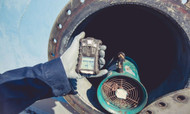5 Most Common Types of Combustible Gases
Posted by William Kimmell on 3rd Jun 2022
Combustible gas is a type of gas that burns when combined with oxygen. The most common types of combustible gases are butane, propane, methane, hydrogen, and carbon monoxide. The explosive range for combustible gases is the lower explosion limit (LEL) and the upper explosion limit (UEL). The lower explosion limit is the lowest concentration of a combustible gas that explodes when combined with air. The upper explosion limit is the highest concentration of combustible gas present in the air. A multi gas detector has an alarm system to cease gas supply and activate ventilation in an area where the gas concentration level exceeds the lower explosion limit. Learn about the five most common types of combustible gases and how their flammable properties can affect the health and safety of occupants.
1. Butane
Each molecule of butane contains four carbon atoms and 10 hydrogen atoms. When the carbon atoms form a straight link, it is a normal butane (n-butane). If the atom chain develops with branches, it is iso-butane. Butane is odorless, clear, and easy to liquify. Butane fuels lighter fluid, portable heaters, and increases the volatility in organic compounds.
2. Propane
Each molecule of propane contains three carbon atoms and eight hydrogen atoms. The extraction of propane comes from refining crude petroleum and gases in their natural form. People typically store propane in tanks attached to gas-powered machinery and appliances like recreational vehicles, heating, and refrigeration. Propane powers homes in rural areas that have limited access to natural gas lines.
3. Methane
Each molecule of methane contains one carbon atom and four atoms of hydrogen. Natural gas has properties of methane in its unfiltered state. Methane formulates chloroform, formaldehyde, freons, and other sources of energy. During the processing of gases, the hydrocarbons and other natural gases are removed, leaving behind fuel that is pure methane.
4. Hydrogen
Hydrogen is an odorless, colorless, and tasteless gas. Most natural gases have a sulfur-containing compound added to make leaks detectable. No known odorant is light enough to diffuse fuel cells at the same rate as hydrogen, which means the odor is undetectable until after hydrogen gas concentrations exceed the lower flammability limit.
5. Carbon Monoxide
Carbon monoxide develops from the incomplete combustion of multiple fuels. Carbon monoxide is highly toxic. Carbon monoxide goes undetected because it is odorless and colorless, which is why carbon monoxide detectors are imperative in occupied spaces.
Combustible gases are a common source of gas explosive incidents on worksites and inside living quarters. It’s critical to install combustible gas detectors for living spaces and the intakes to HVAC air ducts.
TG Technical Services is the hub for gas detecting technology to help you identify hazardous gases in an indoor environment. Explore our broad selection of gas monitors and devices to ensure the health and safety of your home or worksite today. Take a look at our fixed gas monitors today!

